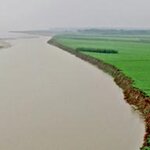Archaeology

The Brus, written by John Barbour, Archdeacon of Aberdeen, in about 1375, covers the Wars of Independence waged by Robert the Bruce, and includes a vivid, early description of the Battle of Bannockburn, which will have its 700th anniversary this week.
It is one of the best-known works written in early Scots and its central theme - that freedom is a prize worth winning at all costs - has resonated in Scotland through the ages and is a poignant reminder before the Scottish Independence Referendum.
No edition of the 1,400 line poem written in Barbour’s own hand survives, but two early versions,…
In a marked cemetery northwest of Lake Baikal, a skeleton was found, buried ceremoniously with a nephrite disk and four arrowheads, one of which was broken and found in the eye socket. An arrow in the eye? That's no accident.
After radiocarbon dating and analysis, it was determined the individual was a 35-40 year-old male from the early Bronze Age, between 2406 and 1981 B.C.
Unlike most hunter-gatherer societies of the Bronze Age, the people of the Baikal region of modern Siberia (Russia) respected their dead with formal graves. This particular specimen was so unique that bioarchaeologist…

Nature gets a bad rap, according to a new paper. For thousands of years, fickle weather has been blamed for tremendous suffering caused by massive flooding along the Yellow River, long known in China as the "River of Sorrow" and "Scourge of the Sons of Han."
Not so, according to a new paper in the Journal of Archaeological and Anthropological Sciences. Instead, the Anthropocene Epoch didn't start 150 years ago, or even in 2000 A.D. when it was coined and became the buzzword for environmentalists worldwide - it started 3,000 years ago.
The authors blame the river's increasingly deadly…

Shakespeare characterized Richard III as a hunchback because his personal and physical deformities were well known. Certainly some history is written by the winners, and he was a big loser in the War of the Roses, but now everyone can explore the true shape of one of history's most famous spinal columns.
Multimedia experts have created a 3-D model of Richard III's spine and the visualization reveals how the king's spine had a curve to the right, but also a degree of twisting, resulting in a "spiral" shape. During analysis, the skeleton was analyzed macroscopically for evidence of spinal…

Who had the privilege to spend eternal life next to the pharaoh?
Kids and other family members, much like today. If you can afford a tomb, that is.
In the Egyptian Valley of the Kings, excavations by Egyptologists from the University of Basel have been working on tomb KV 40, close to the city of Luxor, for three years. From the outside, only a depression in the ground indicated the presence of a subterranean tomb. Up to now, nothing was known about the layout of tomb KV 40 nor for whom it was build and who was buried there.
The Egyptologists assumed that it was a non-royal tomb dating…

A new study suggests that early humans living thousands of years before Neanderthals, were able to work together in groups to hunt and slaughter animals as large as the prehistoric elephant.
University of Southampton archaeologist Dr. Francis Wenban-Smith discovered a site containing remains of an extinct straight-tusked elephant (Palaeoloxodon antiquus) in 2003, in an area of land at Ebbsfleet in Kent, during the construction of the High Speed 1 rail link from the Channel Tunnel to London. Investigation of the area was carried out with independent heritage organization Oxford Archaeology,…

The inscription on a 3,500-year-old stone may be one of the world's oldest weather reports - and it could cause us to revise our chronology of the ancient Middle East.
The 40-line inscription is on a 6-foot-tall calcite block called the Tempest Stela was found in the 3rd Pylon of the temple of Karnak at Thebes between 1947 and 1951 and describes rain, darkness and "the sky being in storm without cessation, louder than the cries of the masses".
The Tempest Stela dates back to the reign of the pharaoh Ahmose, the first pharaoh of the 18th Dynasty. His rule marked the beginning of the New…
The Dig for Richard III, authorized by the Leicester City Council and commissioned and paid for by Philippa Langley of the Richard III Society, unearthed a body and it was declared that of Richard III.
But not everyone was convinced. In an interview with BBC History Magazine, Michael Hicks, head of history at the University of Winchester, and Martin Biddle, archaeologist and director of the Winchester Research Unit, raised concerns about the DNA testing, radiocarbon dating, damage to the skeleton and that the excavation field records have remained sealed by the University of…

Did the Polynesians beat Columbus to South America?
Not according to archaeological
evidence. The new tale of migration was uncovered by analysis of ancient DNA from...chicken bones.
The ancient DNA has been used to study the origins and dispersal of ancestral Polynesian chickens, reconstructing the early migrations of people and the animals they carried with them.
The study led by the University of Adelaide's Australian Centre for Ancient DNA (ACAD) published in Proceedings of the National Academy of Sciences reveals that previous claims of contact between early Polynesians and South…

The Byzantine Empire arose after the death of the Roman Emperor Constantine. To make the empire more manageable, it was split into eastern and western halves, with Rome as the seat of the west and Constantinople as the capitol of the east. Unlike Rome of the time, the Byzantine Empire coupled military might and the religious authority of the Church.
When the Roman Empire collapsed and led Europe into the Dark Ages, the Byzantine Empire continued on and it continued to modernize. You don't last for a thousand years, including holding off Muslim invaders for much of that time, without doing…